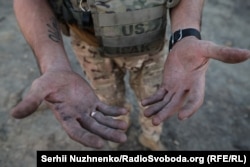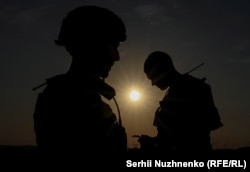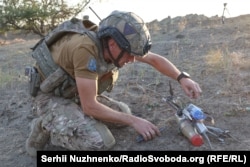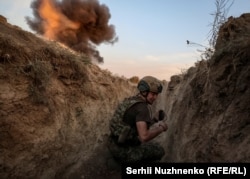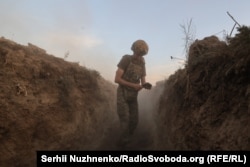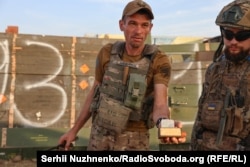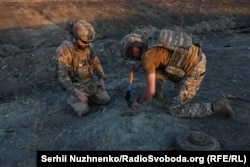"If you're not an experienced sapper, you can go on a mission, but you may not come back," jokes Andriy, the commander of a platoon of Ukrainian sappers.
We are meeting with Andriy, whose call sign is "Porthos" after one of the Three Musketeers, at a recreation center in the Donetsk region. It's already getting dark outside. We meet late because the fighters had combat tasks around the eastern Ukrainian city of Bakhmut during the day.
There's no shortage of work for sappers here. Virtually every meter of the front line is mined.
Andriy joined the army in March 2022, just after the full-scale Russian invasion was launched. He had no military experience.
"I was living in Portugal from 2009 to 2013," he recalls. "I returned to Ukraine after my daughter was born. My wife and I decided that we want her educated here in Ukraine so that she thinks the way we do," Andriy says.
In Portugal, Andriy worked as a mason. He was surprised that in the Western European country many workers had no education, and some were illiterate.
"When a person received their salary and had to sign for it, some of them would just mark it with a cross," he says.
Soon after he arrived back in Ukraine, Russia forcibly annexed Crimea and unleashed the first phase of the war in eastern Ukraine. Then came the 2022 invasion.
"I didn't get to the front lines right away," Andriy recalls.
First, he passed basic military training, then later specialized in being a sapper tasked with various military engineering tasks, most importantly working with mines.
"I got to the front lines in July 2022. That was when my military career started," Andriy says.
Andriy and his unit endured some of the toughest battles in Ukraine's east, defending Bakhmut and Soledar for as long as they could before both cities were captured by the Russian advance. Today, he works to the south of Bakhmut.
"What you see in war movies is all fairy tales. It is completely different in reality," Andriy says. "Conflict is something that changes every minute, every second. It's not possible to be ready for everything."
During his first experience of battle, the veteran recalls, "there was no fear, but perhaps if I'd known what was coming there would have been."
"I felt fear after the first combat missions," Andriy says. "Sometimes, the pick up for a mission was scheduled for 11 p.m., so the car arrives in the middle of the night. As they say, waiting for death is worse than death itself."
It was when returning from a combat mission, he says, that fear crept in.
"You arrive back at the evacuation point where it's calmer and you start to think about where you just were and what you were doing," he says. "Yes, that's when the fear comes."
Andriy recalls an operation to mine an area near Bakhmut that was one of his team's most dangerous missions.
"A position was stormed by Russian troops and we were assigned with getting in and mining it. We completed our mission [of installing mines] and returned to our positions. The next day, the battalion commander arrived and said that this work should be done by a special operations team. That is, we were not trained for such tasks," Andriy says.
After this operation, he says, he and his team "considered ourselves good soldiers."
The hardest part of fighting, the sapper says, "is seeing your wounded brother next to you when you can't help him."
After living alongside his brothers-in-arms, Andriy says, "you become attached, you become like family. Then when you start to lose that person, and you can't help, it's very scary. You don't know what you can say to his family afterwards. This is the greatest fear -- to feel helpless and unable to save a close friend."
In the evening of the next day, we go with Andriy and his team to a training area behind the front lines where several small groups are shooting at targets and simulating assault missions. Andriy pulls out charges for grenade launchers, various types of mines, and a bomb-carrying FPV drone that had failed to reach its target. He lays out everything to demonstrate how dangerous "toys" are neutralized.
"If you see that there are no beeps or flashing lights, then you can approach the drone at your own risk and inspect it," Andriy explains.
According to official rules, it's best not to approach any weaponized drone. Ideally, it should be destroyed remotely. But with enough experience, it can be worth attempting to salvage a drone.
"The first thing to do is disconnect its main battery. The second is to examine the explosive payload and find its detonator. Then you carefully disconnect the detonator from the ammunition," Andriy explains.
"If you see an additional battery, you try to deactivate that. Only then, we remove the ammunition, which will be destroyed. If it's possible to demine the drone, it will go to our drone pilot friends for spare parts," says Andriy.
Next, the fighters put a TNT charge on top of some ammunition and remote-controlled detonators are installed.
We take cover, then hear, "Fire in the hole!" Stones rain down and a cloud of dust rises. The explosion was at least 30 meters away, but you can feel the blast wave thump in your chest. The stink of explosives lingers in the air.
An equally difficult situation is how to neutralize an anti-tank mine. Often, Russian forces hide "anti-lift" explosives that set off the larger mine when a sapper attempts to remove it.
If there is any danger of such a device lurking below an anti-tank mine, a special technique is used to remotely move the mine, which Andriy demonstrates. We return to the shelter again. A rope runs from our position in the trench to the mine. A soldier jerks the mine from its place with a sharp pull of the rope and an explosion rings out across the training ground.
Using this method, a Ukrainian sapper would be unharmed, but there are many tricks Russian troops resort to to inflict maximum damage on sappers.
Some of Andriy's stories illustrate the dangers of the battlefield itself.
"One of our soldiers had rigged a doorbell to be a detonator. I don't know what he was thinking, but he decided to hang this doorbell in a tree," Andriy recalls. "Then the Ukrainians had to withdraw from this position. Russian troops stormed the area and one of the enemy soldiers -- God knows what he was thinking either -- pressed the button. An explosive device was linked to the bell and half of his group was killed in the blast."
One of Andriy's closest calls was when encountering a Russian POM-3 mine. The dreaded, air-dropped device is fitted with a seismic sensor sensitive enough to explode if someone walks into its kill radius.
"We had demined the territory in one area. Everything was going smoothly. Then our driver spotted a parachute from one of these mines. Then he took a few more steps and he called out that he thinks he can see a POM-3 mine. Everyone froze because it should have detonated already," Andriy says. "It seems the mine's battery had run out. It should have self-destructed, but it hadn't. We decided to shoot it with a machine gun from a safe distance. It didn't explode but just broke into pieces.
"Later, we were given the mission to head into this same field to pick up a fallen drone," Andriy continues. "We looked for a safe area to enter this field, but there were empty containers from POM-3 mines lying all over the place. It was pretty clear these mines were scattered throughout the area. The commander was informed, and he called off the task. He decided the life of a sapper was not worth a drone."
"There is an opinion that sappers are disposable troops," Andriy says, half-jokingly.
As for the psychological support, Andriy says, "Your military family, the brothers with whom you live, are your most important network. Without them, things would become intolerable very quickly. There are seven people in our team. We all live together under one roof. There are older guys and younger, but we all support each other.
"Then it is your wife -- this support is important. Then there is my daughter, who rings me and says: 'Dad, you can always call. At any time, call me, talk to me.'"






